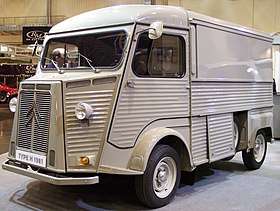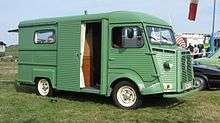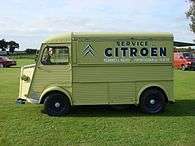Citroën H Van
The Citroën H Van, Type H, H-Type or HY is a panel van (light truck) produced by the French automaker Citroën between 1947 and 1981.[1] It was developed as a simple front wheel driven van after World War II. A total of 473,289 were produced in 34 years in factories in France and Belgium.
| Citroën H Van | |
|---|---|
 Front 3/4 view showing spare wheel compartment: post 1969 model with rectangular rear wings and suicide doors | |
| Overview | |
| Manufacturer | Citroën |
| Production | 1947–1981 |
| Assembly | France: Paris Spain: Vigo (Centro de Vigo) |
| Body and chassis | |
| Class | Light commercial vehicle (M) |
| Body style | 4-door panel van |
| Layout | FF layout |
| Chronology | |
| Predecessor | Citroën TUB |
| Successor | Citroën C25 Citroën C35 |


_-_Flickr_-_FaceMePLS.jpg)

.jpg)
.jpg)
Design
Like the 1934 Citroën Traction Avant, the H had a unitary body with no separate frame, front independent suspension, and front-wheel drive. For a commercial van, this combination provided unique benefits – a flat floor very close to the ground, and 6 ft (180 cm) standing height, with a side loading door.[2]
The distinctive corrugated bodywork used throughout the period of production was inspired by German Junkers (Aircraft) starting from the First World War until the 1930s, the three-engined Junkers Ju 52 being the last to use this construction.[3] Henry Ford also adopted this construction for the Ford Tri-Motor passenger aircraft. The ribs added strength without adding weight, and required only simple, low-cost press tools. The flat body panels were braced on the inside by 'top hat' box sections, at right angles to the ribs. The welded floor was strong enough to support a horse.[2]
Marketing
Most H Vans were sold in France, Belgium and the Netherlands. At the Slough Trading Estate assembly facility (1926-1966), Citroën UK built a very small number of right hand drive versions.[2] The German market was supplied by a key competitor, the Volkswagen Type 2, and also by the more comparable DKW Schnellaster.
As with the Volkswagen, the H Van could not be sold in the US as a commercial vehicle after 1964, due to the Chicken tax.[4]
Mechanical
The engine, gearbox and many smaller parts are shared with other Citroën models.[1] The engine and gearbox are nearly identical to those in the Traction Avant and later the DS, only mounted with the engine in front of the gearbox.[2] The headlights were identical to those of the 2CV, while speedometers were successively borrowed from the Traction Avant and the Ami 6.
While the derated Traction avant 4 cylinder engine and the unsophisticated 3 speed gearbox (non syncromesh on first gear) only gave a modest top speed of just under 100 km/h, the chassis and suspension layout provided good roadholding qualities for a van of the era, especially on the short wheelbase version: low slung chassis, with very little overhangs, combined with sophisticated totally independent suspensions (the front ones used double torsion bars instead of conventional coil springs). The 1.9 liter motor offered more usable power than the 1.2 liter motor of its competitor, the 1950 Volkswagen Type 2.[2]
Styling changes
The basic design changed very little from 1947 to 1981.
Vehicles left the Citroën factory with only three body styles: the standard enclosed van, a pick-up version, and a stripped-down body which went to non-Citroën coach-builders and formed the basis for the cattle-truck and other variants. The basic version had an overall length of 4.26m, but vehicles were also available in a LWB version with an overall length of 5.24m.[5]
In September 1963 the earlier style rear window - a narrow vertical window with curved corners - was replaced with a square window the same height but wider, 45 cm on each side. The bonnet was modified to give two additional rectangular air intakes at the lower edges, one for a heater, the other a dummy for symmetry.
In early 1964, the split windscreen used since 1947 was replaced with a single windscreen, while in late 1964 the chevrons on the radiator grille, previously narrow aluminum strips similar to those on the Traction Avant, were replaced with the shorter, pointed style of chevrons as used on most Citroën vehicles in the last decades of the twentieth century.
In November 1969 the small parking lights were discontinued, the front indicators were recessed into the wings, and the shape of the rear wings was changed from semi-circular to rectangular.
Rear hinged 'Suicide' cab doors were used until the end of production in 1981, except on vehicles manufactured for the Dutch market where conventionally hinged doors were available from 1968.[6]
Names
Citroën's teams worked on 8 projects and only the last one was developed, giving it its name : "H". Most Type H vans were sold as model HY. Other models include H (early versions), HX (lesser load capacity), HP (flat-bed pick-up), HZ, and HW (greater load capacity). For a time they were also sold as model 1600. When used by the police, it was called "panier à salade" ("salad basket").
References
- "CITROËNS HISTORIE: JANUAR 1947 LANCERING AF CITROËN TYPE H". Citroen.dk (in Danish). Retrieved 10 August 2016.
- "Citroen H Van History". Retrieved 10 August 2016.
- Gijsbert-Paul Berk, Andre Lefebvre and the Cars He Created at Voisin and Citroen , Veloce, Paris, 2009, ISBN 978-1845842444, p.95
- Ikenson, Daniel (June 18, 2003). "Ending the 'Chicken War': The Case for Abolishing the 25 Percent Truck Tariff". The Cato Institute. Archived from the original on September 21, 2011. Retrieved August 11, 2016.
- Wouter Jansen et Fabien Sabatès, "H" Comme Citroën - Le Cube Utile, Editions Charles Massin, Paris, 1992, ISBN 2-7072-0194-4, p.70
- Wouter Jansen et Fabien Sabatès, "H" Comme Citroën - Le Cube Utile, Editions Charles Massin, Paris, 1992, ISBN 2-7072-0194-4, p.154
External links
| Wikimedia Commons has media related to Citroën HY. |
| Preceded by: Citroën TUB |
Succeeded by: Fiat_Ducato#Citroën_C25Citroën C25 Citroën C35 |